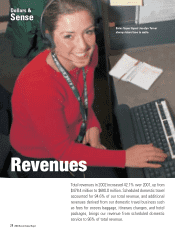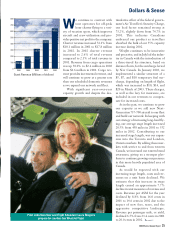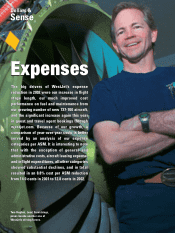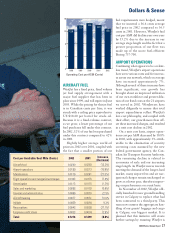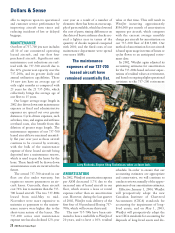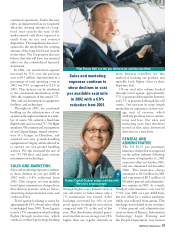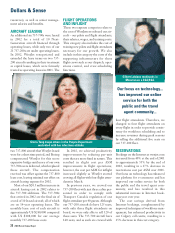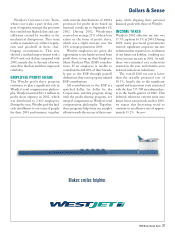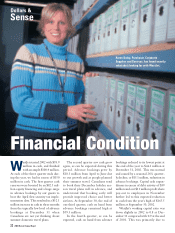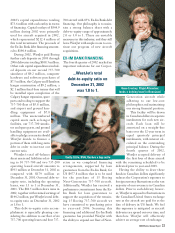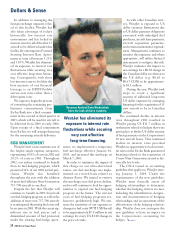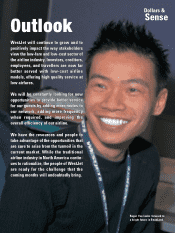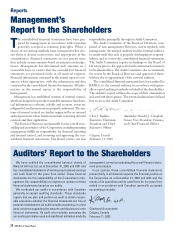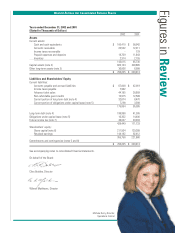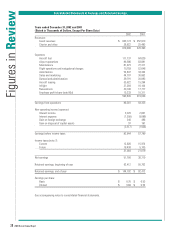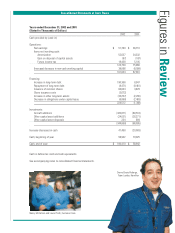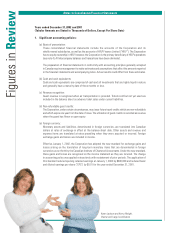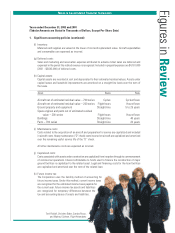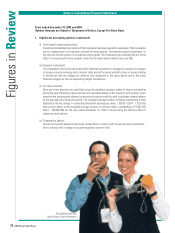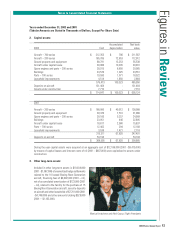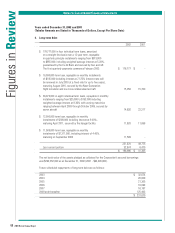Westjet 2002 Annual Report Download - page 34
Download and view the complete annual report
Please find page 34 of the 2002 Westjet annual report below. You can navigate through the pages in the report by either clicking on the pages listed below, or by using the keyword search tool below to find specific information within the annual report.
In addition to managing the
foreign exchange exposure relat-
ed to this facility, WestJet has
also taken advantage of today’s
historically low interest rate
environment and has locked in
interest rates for all of the first 15
aircraft to be delivered under this
facility. By entering into Forward
Starting Interest Rate Agree-
ments at rates of between 5.25%
and 5.85%, WestJet has eliminat-
ed its exposure to interest rate
fluctuations while securing very
cost effective long-term financ-
ing. Consequently, with these
low interest rates we feel that the
best measure of our financial
leverage is an EBITDA/debt
service-cost ratio rather than a
debt/equity ratio.
We expect to begin the process
of converting the remaining pre-
liminary commitments from
Ex-Im Bank into a final commit-
ment in the second or third quarter of
2003, which will be used for aircraft to
be delivered from 2004 to early 2006.
Upon receipt of a final commitment
from Ex-Im, we will arrange financing
for the remaining aircraft deliveries.
RISK MANAGEMENT
WestJet’s fuel costs constitute one of
the largest single expense categories,
representing 18.8% of costs in 2002 and
20.2% of costs in 2001. Throughout
2002, our airline continued to benefit
from its fuel-hedging program, which
protected 32% of our 2002 jet fuel pur-
chases. WestJet also benefited
throughout the year with the addition
of more fuel-efficient Next-Generation
737-700 aircraft to our fleet.
Despite the fact that WestJet will
continue to benefit in 2003 from both
our fuel-hedging program, as well as the
addition of more new 737-700 aircraft,
it is anticipated that rising fuel costs will
be an issue in 2003. With the recent sig-
nificant rise in fuel prices and a
diminished amount of fuel protected
under the existing fuel-hedge agree-
ment, we implemented a temporary
fuel surcharge effective January 10,
2003, and increased this surcharge on
March 7, 2003.
In order to minimize the impact of
this charge on our ultra-short-haul
routes, our fuel surcharge was imple-
mented on a tiered basis relative to
distance flown. We intend to remove
this surcharge once fuel prices decline,
and we will continue to look for oppor-
tunities to expand our fuel-hedging
program in the future. The current
costs of fuel-hedging programs are,
however, prohibitively high. We esti-
mate the sensitivity of our exposure to
changes in fuel costs (WTI US$/barrel)
to be approximately $1.9 million in net
earnings for every US $1.00 change in
the price of crude.
34 2002 WestJet Annual Report
As with other Canadian carri-
ers, WestJet is exposed to US
dollar currency fluctuations due
to US dollar payment obligations
associated with unhedged fuel
purchases, aircraft lease payments,
aircraft acquisition payments,
and certain maintenance expendi-
tures. Management continues to
monitor this exposure, and where
appropriate, will utilize financial
instruments to mitigate this risk.
WestJet estimates the impact to
net earnings for a $0.01 change in
the Canadian dollar in relation to
the US dollar (e.g. $0.68 to
$0.67 CDN) to be approximate-
ly $1.1 million.
During the year, WestJet took
steps to avoid a significant
amount of additional long-term
US dollar exposure by arranging
financing for the acquisition of 15
new aircraft to be in Canadian
dollars.
The continued decline in interest
rates throughout 2002 resulted in
WestJet paying US $11.7 million in
settlements related to hedges that were
put in place to fix the US dollar amount
of lease payments on the Corporation’s
10 new aircraft leases. This continued
decline in interest rates provided
WestJet an opportunity to lock in inter-
est rates on the Ex-Im Bank guaranteed
financing related to the acquisition of
15 new Next-Generation aircraft at his-
torically low levels.
The CICA issued an accounting
guideline that applies to WestJet start-
ing January 1, 2004. Under the
requirements of the new guideline,
WestJet must formally assess all
hedging relationships to determine
whether the hedging criteria are met,
including the identification, designa-
tion and documentation of hedging
relationships, and an assessment of the
effectiveness of the hedging relation-
ship. WestJet does not anticipate the
new guideline to have an impact on
the Corporation’s accounting for
hedges.
Dollars & Sense
Revenue Analyst Dave Nickolchuk
likes the look of these numbers.
WestJet has eliminated its
exposure to interest rate
fluctuations while securing
very cost effective
long-term financing.


